9/7/04 - day 5 |
| Fishing and gathering |
|
When we woke this morning at our midnight campsite, the sun was out and there was a slight breeze out the bay in our direction. It's an understatement to say the sun was out. The sky was absolutely perfectly clear in all directions with only the sun and the moon to mark it. We were eager to get going after our lazy breakfast. So we left Northwestern Lagoon with barely a look at its unmapped shapes peeking out in the wake of the glaciers. We were headed for new things. |
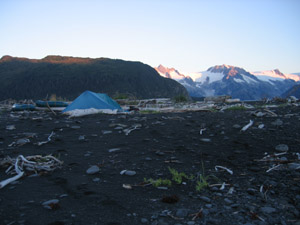 |
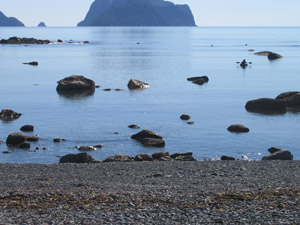 |
|
As soon as we plopped our rafts in the water, the wind turned. The nice breeze was now dead against us and growing. We slogged against it, paddling for miles alongside a gravel beach which taunted us, showing how nice it would have been to walk. But you never can tell until you're there. We had the rafts already blown up, and knew there were cliffy headlands up ahead. We paddled as close to the shore as we could without getting swept up in the breakers. The swell was a couple feet high, and it crashed and splashed on all the rocks and beaches. The wind against us made small choppy waves over the top of it, sending the raft on a thumping bumping course over the water and slowing its progress. The shoreline was lined with dead trees still standing from the '64 land drop kill, steep talus slopes with rolling rocks and puffs of dust, and best of all the cliffs. Caves and arches snake through their rock walls, swells focus and galoosh into their cracks, and the rise and fall of the ocean against them uncovers sea stars and other life.
The wind slowed us down enough that we weren't eager to keep going, and we'd been meaning to do some ocean fishing for days. Cup Cove was the first indentation on the map, and it was beautiful. Crystal clear water, sea stars on all the rocks, kelp and other life thick on the bottom, and two nice landing beaches.
We'd bought hooks and a lure and some line in Valdez, so we dumped our packs on the shore and headed out to try our luck in the shade of the cliffs. It was a somewhat entangling setup, without the benefit of a fishing reel, but seemed doable. Hig took the lure and trouble hook, while I baited another hook. Almost immediately, Hig started pulling out kelp greenling. He'd caught 4 before I even got something to try my bait, though the thing that tried unfortunately didn't get hooked. We decided to switch so I could try the lure for awhile, and in the process Hig caught yet another greenling, just jigging along the bottom. The two males were darker and smaller than the three females, and they probably weighed between about one pound for the smallest to maybe four or five pounds for the largest. Hig left me with the lure and line and paddled back in to shore with his raft load of fish. |
|
It was easier than I expected. I went up close to the cliffs and was just moving my line up and down to see whether I'd hit the bottom yet, when I felt the line jerk spasmodically away from me. Slowly from the depths emerged another beautiful greenling, thrashing as I pulled it through the water. I wanted to eat it, and I was pretty sure there were plenty of greenling in this cove, but I'd never been faced with actually killing the thrashing fish before. Despite the fact that I was the one killing it, I jumped nervously every time it twitched. I tried to do it quickly, stabbing my knife into the veins in the gills like Hig said he had done. But it just kept flopping, and I couldn't tell if it was still alive or just jerking on muscle reflex. I ended up cutting the head half off, dripping fish blood on my raft and assuring myself that any further jerks were not signs of life.
We didn't need any more fish than that. We had a royal feast of fish, cooking them on a rock on the fire and making fish head soup with dock and beach greens. They were amazingly tasty, especially with pepper and a touch of our sesame oil. We juggled a line of little fires, trying to keep a big one going to the smaller ones and to warm us, one for our fish frying, one for the soup, and one to refine salt for the fish from sea water in the pot lid. It was delicious and messy, and just a little too much fish for our hiking-shrunken stomachs. We managed to eat all but two fish heads, but would have been better off with five than six fish. |
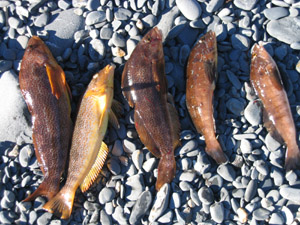 |
|
And then we dashed across the cove in the dark to camp at the other beach. Piles of bear shit were everywhere. Remembering yesterday's bruises and thinking of the vast amount of fish smell we'd left on the beach, we thought a different campsite might be best.
|
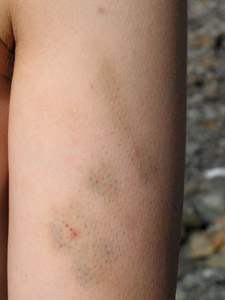 |
|
9/8/04 - day 6 |
| Ocean Life |
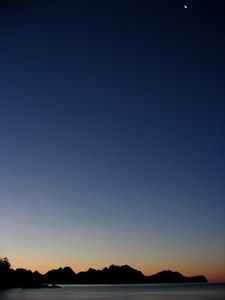 |
We spent today in the bountiful ocean, opting for the paddle around Sandy Point to Paguna Arm over the bushwhacking option. And we couldn't have asked for a better day for it. The wind that held us at Cup Cove yesterday was gone, and the sun shone warm but not hot on the calmer ocean.
|
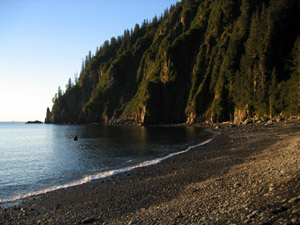 |
No weather here bothers the swell, and it rose and fell the same as every day. The swells rode smoothly under us a couple feet high, and they crashed into the cliffs alongside us. Froth boiled over the rocks as the swells came in, and short-lived waterfalls poured over the seaweed beds as they retreated, briefly exposing a lower zone of the tidal life before the next wave crashed in. The surf focused into cracks and caves, surging up even higher and crashing even more impressively. But most impressive of all was the great blowhole. A cave with only a tiny entrance above water, the incoming waves compress the air inside and it erupts out of the opening with a great bang and a flourish, sending out a great plume of foamy water. The rainbow glitters alongside it and then fades, all to be repeated a few seconds later as the next swell hits. It looked rather like an upside down and intermittent waterfall.
|
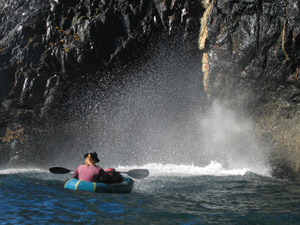 |
|
The ocean is bountiful along these harsh cliffs. Cormorants flew around us in the hundreds, spooked out of their sea cave homes. They flapped valiantly along the surface of the water, each takeoff an unwelcome struggle. Other cormorants sunned themselves on rocks, wings spread, looking in silhouette like a drawing of a dragon. Cormorant shit draped parts of the cliffs in white, and the one sea arch we paddled under stank of them. The sea arches here are monster affairs, narrow tunnels penetrating through mountains worth of rock. |
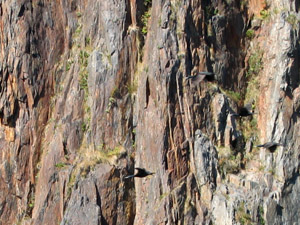 |
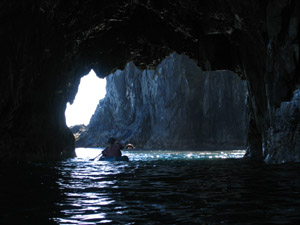 |
As the cormorants flew, the occasional puffin bobbed along in the water, not particularly concerned with our passing. The sea lions were more curious. There were sea lions at every point, periscoping up just outside the surf zone to get a good look at us. We saw one practically jump out of the water, a few that came close enough to our boats to be quite startling, and many many heads and backs from a slightly greater distance. I had one only a few feet from my raft, and they are beautiful swimming underwater.
We saw one sea lion catch a bright silvery fish, probably a herring, shaking it above the water in its mouth. We wanted fish too. Hig had set up our pixee lure for trolling, tied to an alder branch stuck down his coat. We paused by the fishing sea lions to set it up. Hig was untangling the line with the lure dangling down into the water when the rockfish struck. Needless to say, he wasn't ready for it. He managed to get the hook out of the thrashing fish, but then had a very spiny, slippery, and angry fish in an inflatable boat mostly filled by a backpack. The rockfish fought back, poking Hig a few times with its spines as he tried to wrassle with it, and then the fish won, flopping itself out of the boat. Immediately upon putting the lure in the water after that debacle, a herring bit the hook, but it got loose before Hig could get it into the boat.
|
|
So we paddled on, enjoying the wonderful scenery, and dragging a line behind Hig's boat. When the second rockfish hit, we were a little more ready for it. Hig managed to pull it up, kill it, and get it to the next available cooking beach, at the expense of only a few punctured fingers, one punctured seat, and some bloody gear. Rockfish are sharp. After the morning's adventures, we decided Hig's raft has earned the name of Rockfish.
It was a good-sized rockfish, as long as my elbow to my fingertips, and maybe 3 or 4 pounds. She was a pretty grey fish, slightly speckled. And she was a wonderful meal.. We got a couple fillets off the sides, and threw the rest of the meat and the head into a soup. Rockfish is firmer than greenling, also subtle in flavor, and excellent when it's that fresh. The fillets were the perfect lazy man's meal, big bites of fish flesh with no bones or picking. The soup was good too, but it did take a bit of work to dissect, and next time we're definitely taking the scales off.
Around the point the breeze turned with us, and we followed the small waves up Paguna Arm. We were aimed for the head of the bay, after a lengthy discussion of route on a little beach, and much staring at the map. The debate focused on whether we can get over this way, putting us within reach of McCarty Glacier. It's hard to know, especially with much topography not updated since glacial retreat. We're going for it, but I may regret it when the steep scrambles begin.
|
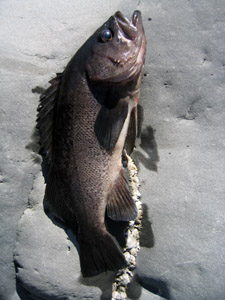 |
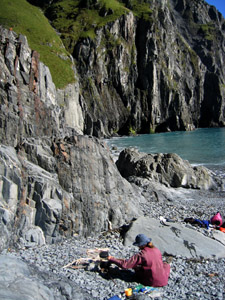 |
|
A little while after this discussion, paddling along with the wind, we realized something was missing. Hig had left his fishing pole on that beach. Now we couldn't lose this magic lure, not after the amount of food it had brought us. So we struggled upwind, maybe twenty minutes, back to the beach to retrieve it. Luckily the surf hadn't washed it away yet. Trolling on the way to the beach with the newly retrieved pole, I caught another herring, and again lost it before it got to the boat.
|
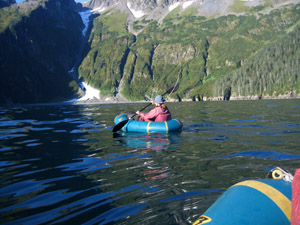 |
|
A pair of problems was awaiting us on the beach we wanted to land on, in the form of a pair of wandering black bears. There's a stream there, so perhaps they can catch salmon. Or perhaps there are just bears everywhere. They seem to be thick around here. So we popped around a cliffy point to the next beach, which seems a little lower traffic.
With all the bear-induced extra movement, we left our fishing grounds behind, and decided to skip straight to dessert. Hot cocoa and oatmeal with huckleberries, oil, and sugar. I think all the bits of gear that need repairing have been, and tomorrow it's a long climb to our questionable pass.
|
|
9/9/04 - day 7 |
| An intrepid pass |
We are huddled against the cold and rain in our shelter at McCarty fjord, listening to the rumbles and crashes as chunks of ice fall into the ocean just up the bay from us. I have been never been close enough before to a tidewater glacier to see it calve. Here in the Kenai Fjords, I just had to. I wanted to see a glacier that made it all the way to the ocean. Not almost to it, not to a sea level lake or behind a beach, but a glacier with a face dropping right into the ocean.
So McCarty, as the biggest tidewater glacier on our route, was the obvious choice. The only problem was the pass. The clearly navigable passes would cut the peninsula far out bay in the fjord, leaving us out at least 10 miles from the face of McCarty. The route by the Delusion Lakes would leave us 6 miles from the face and was completely unmapped, since a glacier filled that valley when the topography was drawn. So we chose the last option. We chose the pass right at the head of the bay. There was one spot on the ascent that was questionable, a section of the descent that looked significantly more questionable, and then we’d be on an unmapped slope under glacial topography. But if it worked, we'd end up almost at the head of McCarty Fjord, right next to a tidewater glacier with a face a mile wide. We had to try it. |
|
First we had to get there. The beach we camped at wasn't quite where we thought, so we blew up our rafts, paddled a mile up along a cliffy coastline, and repacked to head up. Up wasn't hard. We had an annoying patch of salmonberries to wade through, but we were caught by no cliffs.
The clouds had been rolling in all morning, and as we scrambled over rocky boulders near the pass, fog drifted around to enclose us, offering only occasional glimpses of the peaks above, foreshadowing an intrepid journey to come. It was raining for the first time in many days, wetting the boulders we walked on, and slowly sneaking through the cracks and crevices of our clothing to soak us as well. |
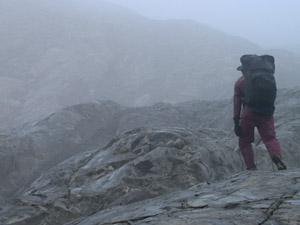 |
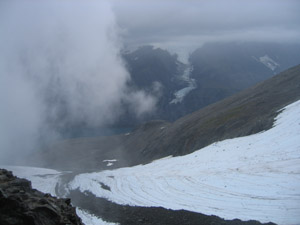 |
Over the pass, we found a glacier. Our originally intended route looked cliffy, so we headed out for the ice, hoping to make it through the crevasse field to the nice stripe of gravel below and hoping to find our way from there off of the glacier. It was a dicey proposition. It was not the fear of hidden crevasses that worried us, since the glacier was almost entirely melted free of snow, but the maze of crevasses we could see. Who knew if we could get through them? |
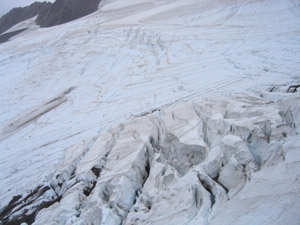 |
|
We worked our way slowly and agonizingly down the glacier, weaving along. Rain fell. The cold breeze blew, and our feet were bathed in a continual pool of slush and ice water. It was cold, scary, and painstaking. Hig cut steps in the ice, while I jiggled and danced in the occasional flat spot to try and stay warm. We couldn't see around the crevasses to know where we were going, and with every step forward I thought about how we might have to backtrack. Not every step had to be cut into the ice, but there were a lot of them. We spent hours on that glacier in the cold blowing rain, thinking about hypothermia, thinking about falling on slippery ice, and thinking about whether we could ever get off of it.
|
Finally, we followed a crevasse down out of the crevasse field. It was a shallow foot-deep V with a stream running down it to the rocks. But it was steep. Rather than cut steps all the way down, Hig cut ice hooks to loop the rope around, and we slithered down the slushy stream in two sections.
We were on the moraine, but not yet off the glacier. We traveled easily for awhile, warming up a little and discussing Alaska history. But the one spot we couldn't see from above was of course the spot that gave us the most trouble. It was a long slope of ice with only a thin scattering of rocks on top to give traction. There wasn't enough slope or enough slide to go careening down it, but every time those rocks slid under my feet, my heart thumped harder.
|
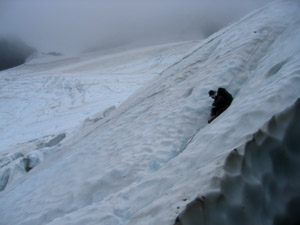 |
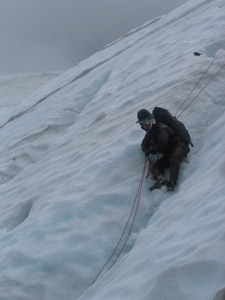 |
|
One more set of steep ice steps, and we were off the glacier, speeding up and warming up walking around on boulders. We knew nothing about the topography and could only rely on hope. And hope came through for us.
We followed the boulder gully all the way down the valley to the beach. I looked at the imposing face of McCarty and the flotilla of icebergs in the bay, and gave Hig a hug. "We made it!" "I bet we're the first ones to do that pass," Hig ventured. I laughed. "I'm sure. Who would ever have a reason to do it? Everyone that comes here is in a boat, and you wouldn't go up there on a day hike." We looked back up at the glacier and contemplated our random achievement, happy we wouldn't have to do it again.
It was already 8:30, but it was a crappy place to camp, and we wanted a better view. So we took off down the beach for a spit sticking out near the glacier. Along the way, we heard many crashes and booms, and managed even to catch sight of one impressive set of falling ice chunks. A harbor seal popped up between the icebergs in the bay.
It was still very wet, and very cold. We set up as quickly as we could, and I prepared food from our warm bed, while Hig cooked it on our driftwood fire. Kraft macaroni and cheese and hot chai, all in silty water, and with a bunch of extra oil on the noodles. It was a treat for a long and intrepid day, but mostly it served to warm my belly.
|
|
9/10/04 - day 8 |
| McCarty Glacier and beyond |
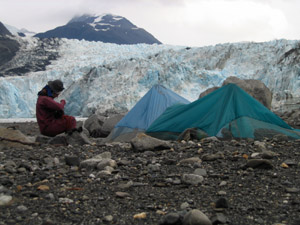 |
The glacier was just awesome. We slept late and lazy in our warm bed, listening to the intermittent rain pattering on our roof, and evaporating some of yesterday's water with our warm bodies. All night we’d heard the crashes of the glacier's violent children, working them into our dreams. And when we crawled out into the cold, there it was, looming over its fjord. It stood out as a ragged monolith of dirty white and blue against the cold grey sky.
We followed our beach up as far as it would go, watching for calving and struggling to keep our hands warm. As the clouds shifted to reveal the peaks above, we could see a new light dusting of snow on everything above 3000 feet.
|
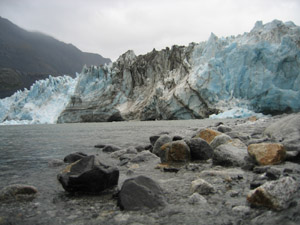 |
The glacier calved as we set up camp, it calved in the night, and it calved in the morning. It's such a massive thing to be in such a hurry to disappear. Its 1905 terminus is over twelve miles out the bay now. We saw both large and small chunks fall, cascading into the water and then splashing up with a great booming sound. The sound always comes a bit too late to look up and see the ice fall, so we relied on luck and time to give us our viewings.
We packed up in our view of the ever-changing face, and paddled out into a flotilla of baby icebergs. Above the surface, most were no larger than a dinner plate. They covered the water in jumbles and floes, forcing the rafts to push them out of the way or to bump right over them. The Alpackas played icebreaker through the mess, and we slowly puttered as close to the glacier as we were willing to go. |
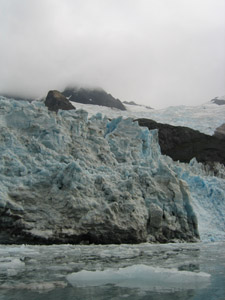 |
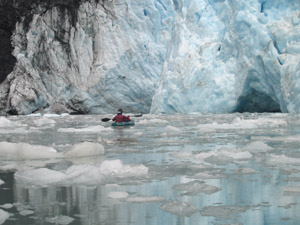 |
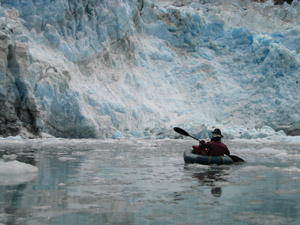 |
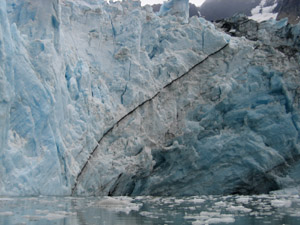 |
|
A flock of seagulls wheeled around the face in a complicated choreography. They would fly right up to the face, settle in the water mere feet from the glacier, and at the next rumble of calving they’d take off again, only to wheel around and return. What seagulls and the harbor seals that spied on us over the edges of icebergs, found to eat at the face of the glacier eluded me. We watched a few more calvings, I took a million pictures, and then we turned and left McCarty behind.
| 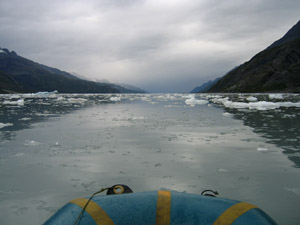 |
|
The rest of the day's journey was mostly unremarkable, paddling out along the young slopes of McCarty fjord. The slopes are a monoculture of alder where they are not still gravel, and the beaches are far more barren of ocean life. But there is some. Seals poked up to examine us occasionally, along with a few otters, and just after our siesta we caught a sculpin. It was an almost accidental fishing encounter. We'd just packed up from cooking a hot meal, Hig was about to set up for trolling, and he must have dropped the lure into the water on top of this poor sculpin's head. So we hurried back to restart our fire and had sculpin for dessert. The flesh is firmer than rockfish and perhaps slightly more rubbery, but still very tasty.
The trolling caught nothing, as usual. I tried to fish off of our campsite here, but dark fell too quickly. After the sculpin, the most remarkable sight of the day was Dinglestadt glacier, shooting down a long notch almost to the ocean, and giving us a view far up to almost its pass. It was a slow grey day and a traveling day, and tomorrow we continue to edge our way out of McCarty fjord. |
|